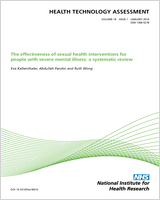Included under terms of UK Non-commercial Government License.
NCBI Bookshelf. A service of the National Library of Medicine, National Institutes of Health.
Blyth M, Anthony I, Francq B, et al. Diagnostic accuracy of the Thessaly test, standardised clinical history and other clinical examination tests (Apley’s, McMurray’s and joint line tenderness) for meniscal tears in comparison with magnetic resonance imaging diagnosis. Southampton (UK): NIHR Journals Library; 2015 Aug. (Health Technology Assessment, No. 19.62.)

Diagnostic accuracy of the Thessaly test, standardised clinical history and other clinical examination tests (Apley’s, McMurray’s and joint line tenderness) for meniscal tears in comparison with magnetic resonance imaging diagnosis.
Show detailsThe data generated by this study suggest that the Thessaly Test is no better at diagnosing meniscal tears than other established physical tests. We found that neither the Thessaly Test alone or in combination with other physical tests could be reliably used by primary care clinicians as an alternative, or surrogate, for MRI scanning to diagnose meniscal tears in the knee.
We have also found that MRI diagnosis of meniscal tears in comparison with arthroscopic diagnosis was less accurate than is commonly reported in the literature. This was particularly true when MRI is used indiscriminately rather than in targeted populations of patients with specific ‘suspected’ knee pathologies. Further well-defined studies are required to determine the true accuracy of MRI for the diagnosis of meniscal tears.
The findings of this study have implications for primary care clinicians who may wish to consider referral of patients with significant knee pain and injuries to a specialist clinician for assessment and treatment rather than automatic referral for MRI of the knee. This approach is likely to maximise the benefit from MRI and minimise the cost of unnecessary or inappropriate imaging.
Recommendation for further research
Further research is required to determine the true accuracy and cost-effectiveness of MRI for the detection of meniscal tears, in a cohort of patients who has not been highly selected by experienced specialists.
- Conclusion - Diagnostic accuracy of the Thessaly test, standardised clinical his...Conclusion - Diagnostic accuracy of the Thessaly test, standardised clinical history and other clinical examination tests (Apley’s, McMurray’s and joint line tenderness) for meniscal tears in comparison with magnetic resonance imaging diagnosis
- Discussion - A manual-based intervention for carers of people with dementia and ...Discussion - A manual-based intervention for carers of people with dementia and sleep disturbances: an acceptability and feasibility RCT
- Study design/methods - Diagnostic accuracy of the Thessaly test, standardised cl...Study design/methods - Diagnostic accuracy of the Thessaly test, standardised clinical history and other clinical examination tests (Apley’s, McMurray’s and joint line tenderness) for meniscal tears in comparison with magnetic resonance imaging diagnosis
- Discussion - Total hip replacement and surface replacement for the treatment of ...Discussion - Total hip replacement and surface replacement for the treatment of pain and disability resulting from end-stage arthritis of the hip (review of technology appraisal guidance 2 and 44): systematic review and economic evaluation
- Introduction - The relative clinical effectiveness and cost-effectiveness of thr...Introduction - The relative clinical effectiveness and cost-effectiveness of three contrasting approaches to partner notification for curable sexually transmitted infections: a cluster randomised trial in primary care
Your browsing activity is empty.
Activity recording is turned off.
See more...